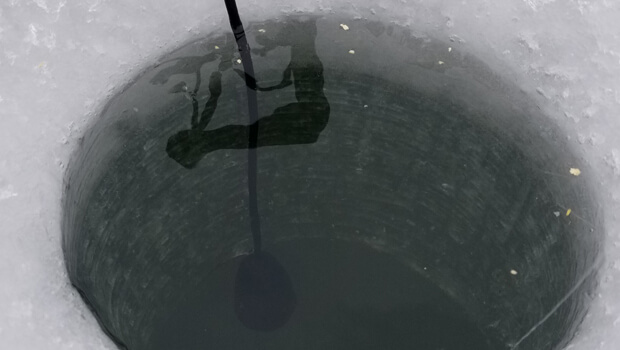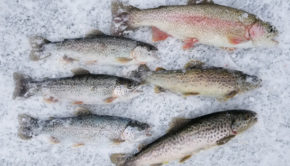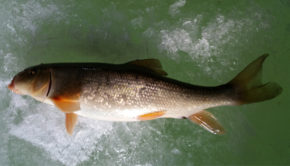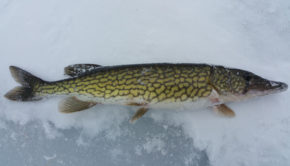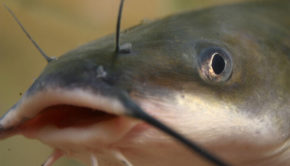How much ice is safe ice?
A very common question that pertains to ice fishing is, “how much ice is safe ice?” There’s a good reason for that. While all sorts of fishing can lead to accidents, ice fishing is perhaps the type of fishing with the most imminent risk. After all, you’re standing on ice floating above freezing cold waters.
So, how much ice is safe ice? A lot of veteran anglers start to feel comfortable when they find two inches of good ice. Some more safety minded people suggest anglers wait for at least four inches of solid ice to start fishing. Others in areas where heavy vehicles and ice houses are used call for anglers to wait on eight inches of ice or more.
Ice thickness and safety
The truth is that the quality of ice has as much to do with strength as its thickness. A solid two inches of crystal clear ice might be enough to support the weight of a grown man with no problem while even a lightweight youngster will quickly go through two inches of sloppy slush.
According to this PDF handout from the Pennsylvania Fish and Boat Commission, two inches of ice or less is unsafe. Three inches can support a single cross country skier. Four inches can support a single anglers. Five inches can support a snowmobile.
As you can see, strength grows immensely once the foundation is there. So four inches can safely hold up a single anglers but just a single inch more can hold up a big heavy snow mobile. Of course this information is a bit strange coming out of Pennsylvania since snowmobiles aren’t allowed on the ice in that state, but the point remains.
According to that PDF, seven inches of ice is good for “group activities” and eight inches is strong enough to hold up a car. By the time you get to 11 inches of ice you can drive a truck on it. That is of course if the ice is all even and good. That’s rarely the case.
Probably of more use on the PDF is the chart in the corner. That has some listings of ice thickness and the weight it can support. I can’t verify the information, but it seems right to me. It says four inches can hold up 200 pounds of weight, five inches can hold up 800 pounds, and seven inches can hold up 1,500 pounds.
How many inches of ice?
I mostly fish on six or seven inches of ice. I find that is pretty much most common thickness I find when fishing on the edge of the ice belt. I have been out on a lot less ice and so far I have never had a problem. I do my best to stay safe though. I carry safety tools and do a lot of checking with a spud bar and my auger. I also use my Berkley Ice Scoop to make sure I get an accurate measurement of ice thickness rather than just guessing as I did for decades prior.
Of course I have also fished on thicker ice. Sometimes we find nine inches or more. A foot isn’t uncommon on the high elevation mountain lakes. Even then there is usually a mix. It’s normal to find two inches of soft white ice on top of six inches of solid clear ice. Sometimes we end up with five inches of dark black ice. That’s normally good too.
In generally the dark black ice is pretty strong. The clear ice is good. If you see white ice or even clear ice with a load of bubbles in it, it’s probably not strong at all. Sometimes if you chisel through the top layer of white ice you’ll still find good clear ice under that.
The best bet is to read reports you can find and then use your eyes, tools and ability to reason. Start on the bank. Drop your spud bar on the ice hard three times. You should be able to chisel out some of the ice this way without going through. If you go through the ice completely or see water come up through on the first or second drop, the ice is most likely not safe. If you don’t go through, drill a hole with your auger and get a look at how thick the ice is and what it looks like.
Variation in ice thickness
Keep in mind that ice right at the shoreline can be soft or even nonexistent even when the rest of the lake is covered in solid safe ice. So just because the ice at shore is a slushy two inches that doesn’t mean it won’t be good two feet further out. Take a look and use your senses. At the same time, six inches of solid ice near shore is no guarantee that the entire lake has the same amount of ice. A lake can have thick ice in a cove but open water in another section. Where logs and trees enter the ice or streams and springs flow in ice can be weakened or non existent. Stay alert.
Ultimately, no ice is entirely safe. Anglers have to be as safe as possible by taking precautions, carrying safety equipment like ice awls and flotation devices, and keeping their eyes open and their minds sharp. That’s the best advice I can give. I’m not a safety professional but this is what I’ve got after years of ice fishing without issue.
You have to take responsibility for yourself when you go ice fishing or do anything else. Use your facilities and don’t be afraid to look or ask for help if you need it. Ice fishing is great but it’s not worth dying over.

